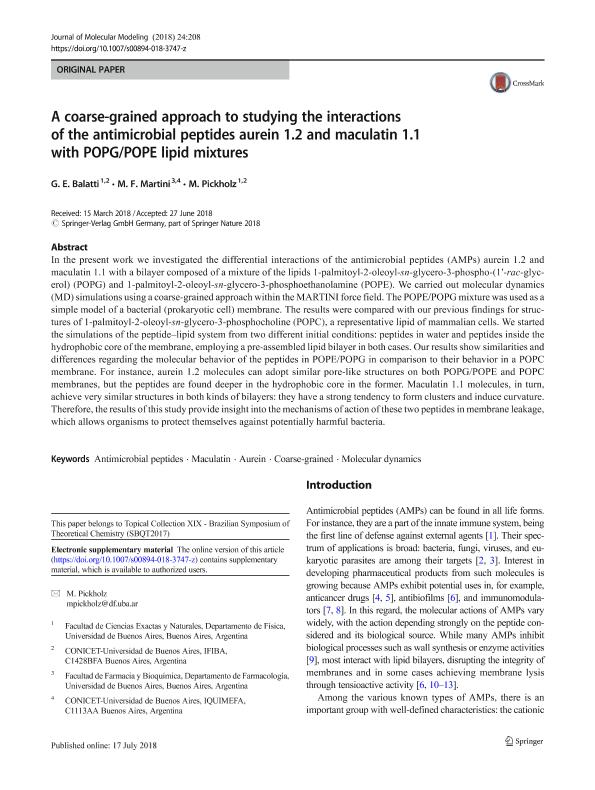Mostrar el registro sencillo del ítem
dc.contributor.author
Balatti, Galo Ezequiel

dc.contributor.author
Martini, María Florencia

dc.contributor.author
Pickholz, Mónica Andrea

dc.date.available
2020-02-05T20:53:17Z
dc.date.issued
2018-08
dc.identifier.citation
Balatti, Galo Ezequiel; Martini, María Florencia; Pickholz, Mónica Andrea; A coarse-grained approach to studying the interactions of the antimicrobial peptides aurein 1.2 and maculatin 1.1 with POPG/POPE lipid mixtures; Springer; Journal of Molecular Modeling; 24; 8; 8-2018
dc.identifier.issn
1610-2940
dc.identifier.uri
http://hdl.handle.net/11336/96786
dc.description.abstract
In the present work we investigated the differential interactions of the antimicrobial peptides (AMPs) aurein 1.2 and maculatin 1.1 with a bilayer composed of a mixture of the lipids 1-palmitoyl-2-oleoyl-sn-glycero-3-phospho-(1′-rac-glycerol) (POPG) and 1-palmitoyl-2-oleoyl-sn-glycero-3-phosphoethanolamine (POPE). We carried out molecular dynamics (MD) simulations using a coarse-grained approach within the MARTINI force field. The POPE/POPG mixture was used as a simple model of a bacterial (prokaryotic cell) membrane. The results were compared with our previous findings for structures of 1-palmitoyl-2-oleoyl-sn-glycero-3-phosphocholine (POPC), a representative lipid of mammalian cells. We started the simulations of the peptide–lipid system from two different initial conditions: peptides in water and peptides inside the hydrophobic core of the membrane, employing a pre-assembled lipid bilayer in both cases. Our results show similarities and differences regarding the molecular behavior of the peptides in POPE/POPG in comparison to their behavior in a POPC membrane. For instance, aurein 1.2 molecules can adopt similar pore-like structures on both POPG/POPE and POPC membranes, but the peptides are found deeper in the hydrophobic core in the former. Maculatin 1.1 molecules, in turn, achieve very similar structures in both kinds of bilayers: they have a strong tendency to form clusters and induce curvature. Therefore, the results of this study provide insight into the mechanisms of action of these two peptides in membrane leakage, which allows organisms to protect themselves against potentially harmful bacteria.
dc.format
application/pdf
dc.language.iso
eng
dc.publisher
Springer

dc.rights
info:eu-repo/semantics/openAccess
dc.rights.uri
https://creativecommons.org/licenses/by-nc-sa/2.5/ar/
dc.subject
ANTIMICROBIAL PEPTIDES
dc.subject
AUREIN
dc.subject
COARSE-GRAINED
dc.subject
MACULATIN
dc.subject
MOLECULAR DYNAMICS
dc.subject.classification
Biofísica

dc.subject.classification
Ciencias Biológicas

dc.subject.classification
CIENCIAS NATURALES Y EXACTAS

dc.subject.classification
Medicina Química

dc.subject.classification
Medicina Básica

dc.subject.classification
CIENCIAS MÉDICAS Y DE LA SALUD

dc.title
A coarse-grained approach to studying the interactions of the antimicrobial peptides aurein 1.2 and maculatin 1.1 with POPG/POPE lipid mixtures
dc.type
info:eu-repo/semantics/article
dc.type
info:ar-repo/semantics/artículo
dc.type
info:eu-repo/semantics/publishedVersion
dc.date.updated
2019-10-22T17:50:52Z
dc.journal.volume
24
dc.journal.number
8
dc.journal.pais
Alemania

dc.journal.ciudad
Berlín
dc.description.fil
Fil: Balatti, Galo Ezequiel. Consejo Nacional de Investigaciones Científicas y Técnicas. Oficina de Coordinación Administrativa Ciudad Universitaria. Instituto de Física de Buenos Aires. Universidad de Buenos Aires. Facultad de Ciencias Exactas y Naturales. Instituto de Física de Buenos Aires; Argentina
dc.description.fil
Fil: Martini, María Florencia. Consejo Nacional de Investigaciones Científicas y Técnicas. Oficina de Coordinación Administrativa Houssay. Instituto de Química y Metabolismo del Fármaco. Universidad de Buenos Aires. Facultad de Farmacia y Bioquímica. Instituto de Química y Metabolismo del Fármaco; Argentina
dc.description.fil
Fil: Pickholz, Mónica Andrea. Consejo Nacional de Investigaciones Científicas y Técnicas. Oficina de Coordinación Administrativa Ciudad Universitaria. Instituto de Física de Buenos Aires. Universidad de Buenos Aires. Facultad de Ciencias Exactas y Naturales. Instituto de Física de Buenos Aires; Argentina
dc.journal.title
Journal of Molecular Modeling

dc.relation.isreferencedin
info:eu-repo/semantics/reference/url/http://hdl.handle.net/11336/62093
dc.relation.alternativeid
info:eu-repo/semantics/altIdentifier/url/http://link.springer.com/10.1007/s00894-018-3747-z
dc.relation.alternativeid
info:eu-repo/semantics/altIdentifier/doi/http://dx.doi.org/10.1007/s00894-018-3747-z
Archivos asociados
